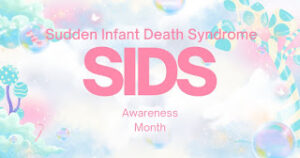Sudden Infant Death Syndrome (SIDS) Awareness Month
October is recognized as Sudden Infant Death Syndrome (SIDS) Awareness Month, dedicated to raising awareness about SIDS, a tragic and often unpredictable loss of life that affects infants under one year old. SIDS, often occurring during sleep, is associated with various risk factors, which health campaigns and organizations aim to mitigate through public awareness and preventive guidance.

Sudden Infant Death Syndrome (SIDS) Awareness Month |
Understanding SIDS and SUID
Sudden Infant Death Syndrome is part of a larger category known as Sudden Unexpected Infant Death (SUID), which includes SIDS, accidental suffocation in bed, and other unexplained infant deaths. This distinction helps families and healthcare providers address risks more comprehensively. As understanding of SIDS has improved, so has the awareness around safe sleep environments as a primary preventive measure, reducing SIDS rates over the years. However, disparities still exist, with infants from Black and Indigenous families being at a higher risk due to socioeconomic and healthcare access factors.
SIDS Awareness Campaign: Key Messages
During SIDS Awareness Month, organizations like the National Institute of Child Health and Human Development (NICHD) promote core messages around safe infant sleep:
- Safe Sleep Environments: Place infants on their backs for all sleep times, use a firm mattress without soft bedding, and avoid co-sleeping.
- Avoid Overheating: Keep sleep environments cool and avoid overdressing infants.
- Smoke-Free Spaces: Exposure to smoke can increase SIDS risk; a smoke-free environment is essential.
The “Safe to Sleep” campaign, organized by NICHD, has been instrumental in disseminating these messages, using toolkits and social media resources to help families understand the importance of each guideline.
Color and Symbol of SIDS Awareness Month
The SIDS Awareness campaign color is pink and blue, symbolizing support and remembrance for infants affected by SIDS and a call for awareness across diverse communities. This color scheme not only honors the lives lost but also reinforces the hope and commitment to reducing future SIDS cases.
Key Institutions Promoting Safe Sleep and SIDS Awareness
Several organizations lead SIDS awareness and safe sleep initiatives, offering resources, research, and support:
- National Institute for Children’s Health Quality (NICHQ): Through community programs and educational resources, NICHQ works on safe sleep and reducing health disparities, particularly for Black and Indigenous infants. They also provide training for healthcare providers to promote awareness and safe sleep practices.
- National Institute of Child Health and Human Development (NICHD): NICHD’s “Safe to Sleep” campaign provides educational resources, toolkits, and social media content to engage caregivers and communities in safe sleep practices. Their resources offer step-by-step guides and visuals for setting up safe sleep spaces.
- U.S. Breastfeeding Committee: This committee emphasizes breastfeeding as part of safe infant care, as breastfeeding has been shown to reduce the risk of SIDS. They work closely with healthcare professionals to integrate breastfeeding education with safe sleep practices.
- Philadelphia Department of Public Health: This department recently launched local initiatives that cater to underserved populations, ensuring families have the resources and information needed to create safe sleep environments for their infants. Their programs are designed to reach diverse communities and address social determinants of health.
Key Resources and Toolkits for SIDS Awareness
For healthcare professionals, caregivers, and community organizations, several toolkits and resources are available to promote safe sleep and SIDS awareness:
- NICHD Safe to Sleep Toolkit: This includes printable resources, online tools, and customizable social media graphics to help spread awareness. Available in English and Spanish, the toolkit covers various aspects of SIDS prevention.
- Social Media Outreach: NICHD’s Safe to Sleep campaign and NICHQ provide sample posts, infographics, and videos, making it easy for organizations and individuals to participate in the awareness drive. This digital approach helps reach a broad audience and encourage knowledge-sharing.
- Local Community Initiatives: Community health organizations like those in Los Angeles County focus on providing SIDS-related support and education. This local focus ensures at-risk communities have access to reliable, culturally sensitive resources.
The Role of Healthcare Professionals
Pediatricians and healthcare providers play an essential role in promoting SIDS prevention. During routine visits, healthcare providers are encouraged to discuss safe sleep recommendations with parents. Breastfeeding and the benefits of vaccinations are also highlighted as part of preventive care, as studies indicate both practices may lower SIDS risk.
Addressing Disparities in SIDS Rates
The disparity in SIDS rates among racial and ethnic groups is significant. Black and American Indian/Alaska Native infants experience SIDS at rates more than double that of white infants. These discrepancies are largely attributed to healthcare access, socioeconomic factors, and historical inequities. National campaigns emphasize the need for tailored approaches and community-specific outreach to address these differences and reduce SIDS rates across all populations.
How to Get Involved
Individuals can support SIDS Awareness Month by:
- Sharing Social Media Posts: Using NICHD’s ready-made social media content, individuals can help spread awareness of safe sleep practices.
- Participating in Fundraising Events: Many organizations, such as the NICHQ, rely on donations to continue their work. Contributions help support research, community programs, and resources for families.
- Educating Family and Friends: Awareness begins at home. Sharing safe sleep practices with friends and family members, especially new or expecting parents, can make a significant difference.
Conclusion
SIDS Awareness Month brings vital attention to safe sleep practices and the ongoing work of health organizations to reduce infant sleep-related deaths. Through targeted education, community support, and healthcare provider involvement, we can make strides toward ensuring every baby sleeps safely. As awareness spreads, so does the hope of reducing SIDS, protecting future generations, and supporting families in creating safe environments for their infants.
